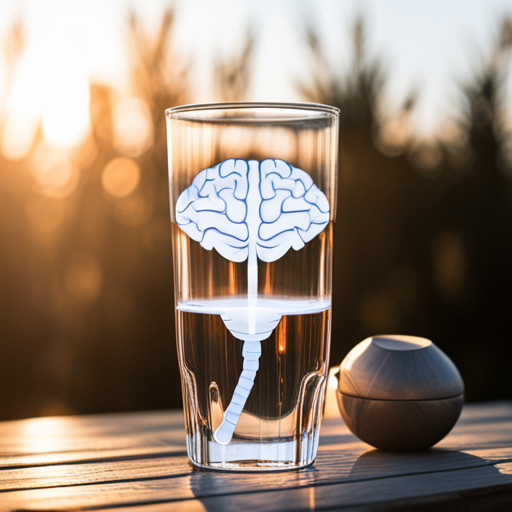Decoding the Link Between Camp Lejeune Contaminated Water and Neurological Conditions
Like a slow-acting poison, contaminated water at Camp Lejeune has insidiously impacted inhabitants' health over decades.

This article critically examines the correlation between this contamination and the onset of neurological conditions.
It delves into the nature of contaminants, their impact on the human nervous system, and the associated legal and medical provisions.
It further explores preventative measures, government roles, and future perspectives in addressing this crisis.
Key Takeaways
- Camp Lejeune experienced one of the largest water contamination incidents in US history, with industrial solvents and contaminants infiltrating the water supply.
- Carcinogenic and neurotoxic chemicals such as trichloroethylene (TCE), perchloroethylene (PCE), and benzene were found in Camp Lejeune's water, with sources of contamination including vehicle maintenance and leaking underground storage tanks.
- The period of water contamination at Camp Lejeune was widespread from the 1950s to mid-1980s, and prolonged exposure to the contaminants increased health risks, especially for developing neurological conditions.
- Exposure to the toxic contaminants in the water can have detrimental effects on the nervous system, potentially leading to neurodevelopmental disorders and neurodegenerative diseases such as Parkinson's disease, Alzheimer's disease, and multiple sclerosis.
Understanding Camp Lejeune’s Water Contamination History

Understanding the history of water contamination at Camp Lejeune necessitates an examination of the military base's operations, environmental standards, and reported incidents of pollution. The base, established in 1941, originally sourced water from the New River and later from wells within the base. Yet, a lack of stringent environmental standards and oversight resulted in one of the largest water contamination incidents in US history.
Firstly, the water sourcing practices of the base were flawed. Industrial solvents and other contaminants from activities at the base infiltrated the water supply. Between the 1950s and 1980s, drinking water in the base was polluted with volatile organic compounds (VOCs) such as trichloroethylene (TCE), tetrachloroethylene (PCE), and benzene. The contamination was linked to waste disposal methods that allowed VOCs to seep into the groundwater, eventually contaminating the wells that supplied the base.
The health implications of this contamination are severe. Exposure to such chemicals potentially leads to a myriad of health conditions. The health consequences among those exposed to the contaminated water at Camp Lejeune are under scrutiny. An association has been found between exposure to the contaminated water and several health conditions, including kidney cancer, leukemia, and non-Hodgkin's lymphoma. Additionally, research indicates a potential link between exposure to these contaminants and neurological conditions.
The Nature of Contaminants Found in Camp Lejeune’s Water

Research into the specific toxins present in the military base's supply has revealed a disturbing array of carcinogenic and neurotoxic chemicals. These substances include volatile organic compounds such as trichloroethylene (TCE), perchloroethylene (PCE), and benzene, all of which have been linked to a variety of health problems. The primary contaminant sources were on-base activities such as vehicle maintenance, industrial cleaning, and leaking underground storage tanks, which allowed these harmful substances to infiltrate the groundwater supply.
The health implications of exposure to these toxins are vast and alarming. For instance, TCE is a potent carcinogen which has been associated with various forms of cancer, such as kidney cancer, non-Hodgkin lymphoma, and liver cancer. Additionally, it is a well-established neurotoxin, capable of causing neurodevelopmental effects in children exposed in utero. Similarly, PCE is a known neurotoxin and can cause liver damage and various types of cancer. Benzene is particularly damaging, having been linked to leukemia and other blood cell cancers.
It is apparent that these contaminants pose a significant threat to human health, especially for those subjected to chronic exposure. Detailed analysis of the specific health effects of each toxin reveals a disturbing pattern: the people on the base were unknowingly exposed to a cocktail of chemicals, each with its own set of dangerous health implications.
Furthermore, these findings underscore the urgent need for rigorous regulation and monitoring of military base water supplies to prevent such widespread contamination in the future.
The Period of Water Contamination at Camp Lejeune

The timeframe of water contamination at Camp Lejeune and the specific contaminants identified serve as crucial elements in understanding the health impact on its residents.
Analysis of the contamination timeline discloses the duration of exposure, which can aid in correlating the extent of health issues linked to the polluted water.
Furthermore, identification and examination of the specific contaminants found in the water provide critical insights into the potential neurological conditions that could be associated with such exposure.
Contamination Timeframe
Establishing the exact timeframe of water contamination at Camp Lejeune is critical to understanding its potential link to neurological conditions. Thorough analysis reveals that contamination was widespread from the 1950s through the mid-1980s.
The primary contamination sources include:
* Industrial solvents discharged from on-site activities
* Leaking underground storage tanks
* Hazardous waste dumpsites
These sources introduced volatile organic compounds into the groundwater, affecting the base's water supply.
The health implications are significant. Exposure to these contaminants increases the risk of developing various neurological conditions. The timeframe of exposure is crucial as prolonged exposure to these toxins amplifies the health risks.
Therefore, understanding the contamination timeline can help in accurately assessing the potential health outcomes for those affected.
Identified Contaminants
Identified contaminants at the site mainly comprise volatile organic compounds (VOCs) including trichloroethylene (TCE), tetrachloroethylene (PCE), and benzene. These contaminants originate from various sources, notably industrial solvents and petroleum products.
Detailed analysis indicates that these substances infiltrated the base's water supply through improper disposal methods, primarily leaking storage tanks and indiscriminate dumping. The VOCs are of significant concern due to their potential health implications. Exposure to such compounds, particularly through ingestion or inhalation, can lead to severe neurological disorders.
Benzene is classified as a known human carcinogen, while both TCE and PCE have been linked to various health conditions including liver damage, kidney dysfunction, and neurological issues. Therefore, the presence of these contaminants signifies a significant health hazard.
How Toxic Contaminants Affect the Human Nervous System
Exposure to toxic contaminants can lead to a range of detrimental effects on the human nervous system, including neurodevelopmental disorders in children and neurodegenerative diseases in adults. Neurotoxic effects of such contaminants are often a result of their metabolism within the body, which can lead to the creation of harmful byproducts that can damage neural tissues.
Some key points to understand about the mechanism of neurotoxicity include:
- Many contaminants can cross the blood-brain barrier, a highly selective barrier that usually prevents harmful substances from entering the central nervous system. This allows them to directly interact with neuronal cells and disrupt their function.
- Contaminants can interact with various key proteins and enzymes within the brain, leading to altered neurotransmission and neural function. This can manifest in a range of neurological symptoms, from subtle cognitive and behavioral changes to severe disorders such as Parkinson's disease or Alzheimer's disease.
- The metabolism of contaminants within the body can often lead to the creation of harmful byproducts. These can further exacerbate the damage to neural tissues, leading to increased severity of neurological symptoms.
Understanding these mechanisms of neurotoxicity is crucial in determining the impact of toxic contaminants on the human nervous system. It also provides insight into potential treatment strategies for mitigation of these effects.
Overview of the Neurological Conditions Linked to Contaminated Water

Several neurological disorders have been found to have a potential connection with the consumption of water contaminated with harmful substances. Among these conditions are Parkinson's disease, Alzheimer's disease, and multiple sclerosis, which are all characterized by the progressive degeneration of the nervous system.
A neurological diagnosis for these conditions often involves a comprehensive evaluation of the patient's medical history, physical examination, and a series of diagnostic tests. Neuroimaging studies, such as computed tomography (CT) scan and magnetic resonance imaging (MRI), are commonly used to visualize any changes in the brain structure. Additionally, a neurological examination may include cognitive tests to assess memory and thinking skills, motor function tests to identify any movement difficulties, and sensory tests to evaluate the patient's sensitivity to stimuli.
Treatment options for these neurological conditions are largely symptomatic, aiming to alleviate the symptoms and improve the quality of life of the patients. Medications, such as dopamine agonists for Parkinson's disease, cholinesterase inhibitors for Alzheimer's disease, and corticosteroids for multiple sclerosis, are commonly prescribed. Physical therapy, occupational therapy, and speech therapy are also integral parts of the treatment plan to help patients manage their symptoms and maintain functional independence.
The link between the consumption of contaminated water and the development of these neurological conditions underscores the importance of ensuring safe and clean water supply. It also emphasizes the need for further studies to elucidate the exact mechanisms of how these harmful substances can affect the nervous system and contribute to the pathogenesis of these neurological disorders.
Epidemiological Studies on Neurological Disorders at Camp Lejeune

Epidemiological investigations have been conducted to assess the potential correlation of neurological disorders among residents and staff at Camp Lejeune. The focus of these investigations has primarily been directed towards understanding the implications of long-term exposure to contaminated water on the neurological health of individuals.
The findings from these investigations have been instrumental in influencing military health policies, with a greater emphasis now placed on ensuring the safety and well-being of military personnel and their families. The investigations have revealed an increased incidence of neurological disorders among those exposed to the contaminated water at Camp Lejeune.
The methodology employed in these investigations often involves:
- Comprehensive health surveys to identify potential cases
- Detailed neurological examinations for definitive diagnosis
- Statistical analysis to establish patterns and correlations
Neurological diagnosis methods have played a pivotal role in these investigations. Sophisticated neuroimaging techniques, neuropsychological tests, and clinical examinations have been utilized to accurately diagnose a range of neurological conditions.
The results of these investigations have had substantial implications on military health policies. A greater emphasis is now placed on the provision of adequate healthcare services for military personnel, with a focus on early detection and treatment of neurological disorders.
Personal Stories: Veterans and Family Members Affected by Neurological Conditions

Personal accounts from veterans and their family members provide a poignant perspective on the impact of neurological disorders. These personal testimonies offer a unique lens through which to view the correlation between exposure to contaminated water at Camp Lejeune and the development of neurological conditions.
The narratives reveal patterns of diagnoses ranging from Parkinson's disease, Multiple Sclerosis, to a variety of other neurological disorders. The onset of symptoms and subsequent diagnoses occurred after extended periods of exposure to the contaminated water, a fact consistently emphasized in these personal testimonies. Furthermore, these accounts detail the struggles faced by veterans and their families, including challenges to their mental, emotional, and physical well-being.
Despite these adversities, the personal testimonies also highlight the veteran's resilience. They underscore their determination to overcome the debilitating effects of their conditions, often through significant lifestyle adjustments, rigorous therapeutic regimens, and unwavering spirit. This resilience is not just a testament to their character, but also a critical component of their journey towards recovery and management of their conditions.
Insights drawn from these personal testimonies contribute to the broader understanding of the link between Camp Lejeune's contaminated water and neurological disorders. They underscore the need for further scientific investigations and policy initiatives to address the apparent health crisis.
Legal and Medical Support for Affected Individuals

Legal and medical provisions play a vital role in assisting individuals affected by environmental contamination-related neurological disorders. These measures ensure that the victims get the necessary help while holding the responsible parties accountable for their actions. Legal ramifications and medical advancements have been instrumental in providing such support.
Legal ramifications come into play when it is established that negligence or malfeasance led to the contamination. Lawsuits can be filed against responsible entities, leading to settlements that provide financial aid for the affected individuals. This can help cover medical costs and compensate for pain, suffering, or loss of income due to disability.
Medical advancements, on the other hand, have made it possible to diagnose and treat environmental contamination-related neurological disorders more effectively. This has significantly improved the quality of life for the affected individuals.
The following key areas highlight the importance of legal and medical provisions in these cases:
- Legal actions: Lawsuits can result in settlements that offer financial relief to the victims, enabling them to afford necessary medical treatments.
- Medical treatments: Advancements in medical technologies and therapies have made it possible to manage symptoms and slow the progression of neurological disorders.
- Research and awareness: Legal ramifications often result in increased public awareness about environmental contamination and its effects on health. This can lead to more research and subsequently, better treatment options.
Prevention Measures: How to Avoid Exposure to Contaminated Water

Prevention measures, particularly in relation to avoiding exposure to contaminated water, represent a critical aspect of safeguarding public health and mitigating the risk of developing neurological disorders. The utilization of advanced water filtration systems forms a significant part of these preventive measures, as they effectively remove harmful chemicals and impurities from the water supply.
Furthermore, emergency preparedness planning also plays an essential role in avoiding exposure to contaminated water, thus reducing the risk of developing neurological conditions. Such preparedness includes having ready access to clean water sources and the ability to test water quality regularly.
Below is a table that visually represents these ideas:
| Prevention Measure | Role | Example |
|---|---|---|
| Water Filtration Systems | Remove harmful chemicals and impurities | Carbon filters, Reverse Osmosis systems |
| Emergency Preparedness | Ensure access to clean water in emergencies | Bottled water supplies, Portable water filters |
| Regular Water Testing | Detect contamination early | Water testing kits, Professional water testing services |
By ensuring that these measures are in place, it is possible to significantly reduce exposure to contaminated water and consequently minimize the risk of developing neurological disorders. The importance of these measures cannot be understated, given the potential long-term health impacts that exposure to contaminated water can have. Thus, the incorporation of these measures into both personal and public health strategies is of utmost importance.
The Role of Government in Addressing the Issue

In the forthcoming exploration of this subtopic, the focus will be on the pivotal role the government plays in rectifying the issue of contaminated water and its neurological impacts.
The in-depth analysis includes an examination of the government's responsibilities in ensuring public health safety, particularly in the context of water contamination.
Additionally, the discussion will highlight the necessity for policy changes, outlining the specific amendments required to fortify the existing regulatory framework and mitigate future occurrences of such health hazards.
Government’s Responsibility
Understanding the extent of the government's responsibility in the case of Camp Lejeune's contaminated water requires a deep examination of regulatory failures, policy decisions, and oversight mechanisms.
It becomes crucial to consider:
- The nature and extent of accountability measures implemented
- The legislative actions taken to prevent such incidents
- The efficacy of oversight mechanisms in place
Substantial regulatory failures led to the contamination, calling into question the efficiency of accountability measures. The absence of stringent legislative actions allowed the issue to persist, leading to devastating health implications. The oversight mechanisms, meant to ensure adherence to environmental and health regulations, failed to detect the issue in a timely manner, furthering the extent of damage.
The government's responsibility, thus, extends beyond mere acknowledgment of the issue.
Policy Changes Needed
Addressing the issues that arose from the Camp Lejeune incident necessitates a comprehensive reevaluation of existing policies and the implementation of new, robust measures to safeguard public health.
This includes a thorough examination of policy reform and legislation improvements that can potentially mitigate such incidents in the future. The need for stringent regulations on water quality standards and regular monitoring of military base environments is evident.
Implementing these reforms, however, requires a careful understanding of the intricate balance between maintaining operational efficiency and ensuring the wellbeing of personnel and their families.
In essence, the lessons from Camp Lejeune underscore the importance of proactive, rather than reactive, policy-making in the realm of public health.
Future Perspectives: Steps Towards Resolving the Crisis at Camp Lejeune

Future perspectives on resolving the crisis at Camp Lejeune focus primarily on extensive research, stringent regulation, and the implementation of effective remedial measures. A critical approach to crisis resolution necessitates a thorough understanding of the scale and impact of the contamination. Long-term health improvement in the affected population requires a comprehensive strategy that encompasses not only medical interventions, but also policy-related actions.
The first step towards resolution involves conducting in-depth research to fully comprehend the spectrum of health issues linked to the contaminated water. The gathered data will provide a solid foundation for creating a targeted plan of action.
Stringent regulations must be imposed to ensure that such a crisis does not recur. These regulations should revolve around:
- Regular mandatory testing of water sources within military bases
- Imposition of strict penalties for non-compliance with environmental standards
- Institutionalization of protocols for immediate action upon detection of contamination
Finally, the implementation of effective remedial measures is crucial. The health improvement of the affected population hinges on the availability of comprehensive healthcare services, psychological support, and compensation schemes.
Frequently Asked Questions
What Is the Current State of the Water Supply System at Camp Lejeune?
The water supply system at Camp Lejeune has undergone substantial improvements to ensure safety and compliance with regulatory standards. Advanced water filtration methods have been integrated into the system while remediation efforts have been employed to rectify past contamination issues.
However, ongoing monitoring is necessary to mitigate any potential future risks. The commitment to maintaining water quality at the camp underscores the importance of a safe water supply in safeguarding overall community health.
Are There Any Potential Psychological Impacts of the Neurological Conditions Linked to Contaminated Water?
Research suggests a potential correlation between neurological conditions induced by contaminated water and subsequent psychological impacts.
With the onset of such conditions, mental health stigma often becomes an issue, exacerbating the psychological distress experienced by affected individuals.
Therefore, the implementation of therapeutic interventions is critical to mitigate these psychological effects.
Further studies are required to understand the full extent of these impacts and devise appropriate management strategies.
How Has the Water Contamination Issue Affected the Local Ecology and Wildlife Around Camp Lejeune?
The water contamination at Camp Lejeune has had significant ecological impacts, particularly on the local wildlife. Changes in animal behavior and adaptations have been observed, suggesting possible responses to the environmental changes.
Notably, alterations in flora and fauna distribution patterns indicate shifts in the ecological balance. However, comprehensive studies are needed to fully understand the extent of these ecological changes and the long-term implications for the local ecosystem.
What Other Military Bases Have Had Similar Issues With Water Contamination?
Contamination sources at military bases, other than Camp Lejeune, have also been identified. Notable instances include the Fort Detrick in Maryland and the Wurtsmith Air Force Base in Michigan where water contamination has been reported.
Despite prevention measures, these incidences indicate a wider problem of water pollution in military installations. Investigation and remediation efforts are required to prevent further environmental and health impacts.
Has the Contaminated Water Contributed to Any Other Health Problems, Apart From Neurological Conditions?
In the aftermath of contamination at Camp Lejeune, numerous lawsuits have been filed, alleging various health issues beyond neurological conditions.
Studies indicate increased incidences of leukemia, kidney disease, and liver damage among exposed populations. Additionally, adverse birth outcomes, fertility issues, and certain types of cancer have been reported.
These findings suggest a broad spectrum of health effects linked to contaminated water exposure, warranting further investigation.
Conclusion
In conclusion, the water contamination at Camp Lejeune is a significant public health problem, highlighting the dire consequences of environmental neglect.
The correlation between toxic contaminants and neurological conditions warrants extensive research and comprehensive preventive measures.
Government intervention and public awareness are paramount in addressing this issue, while dedicated support for affected individuals remains an ethical imperative.
Future perspectives hinge on the collective efforts to resolve the crisis and prevent its recurrence.




